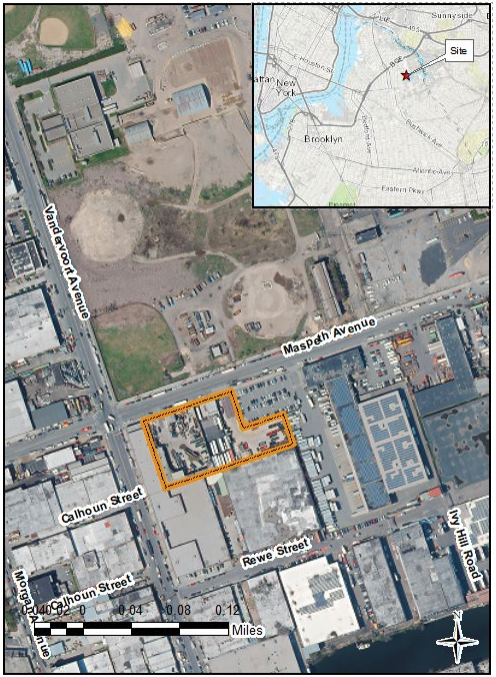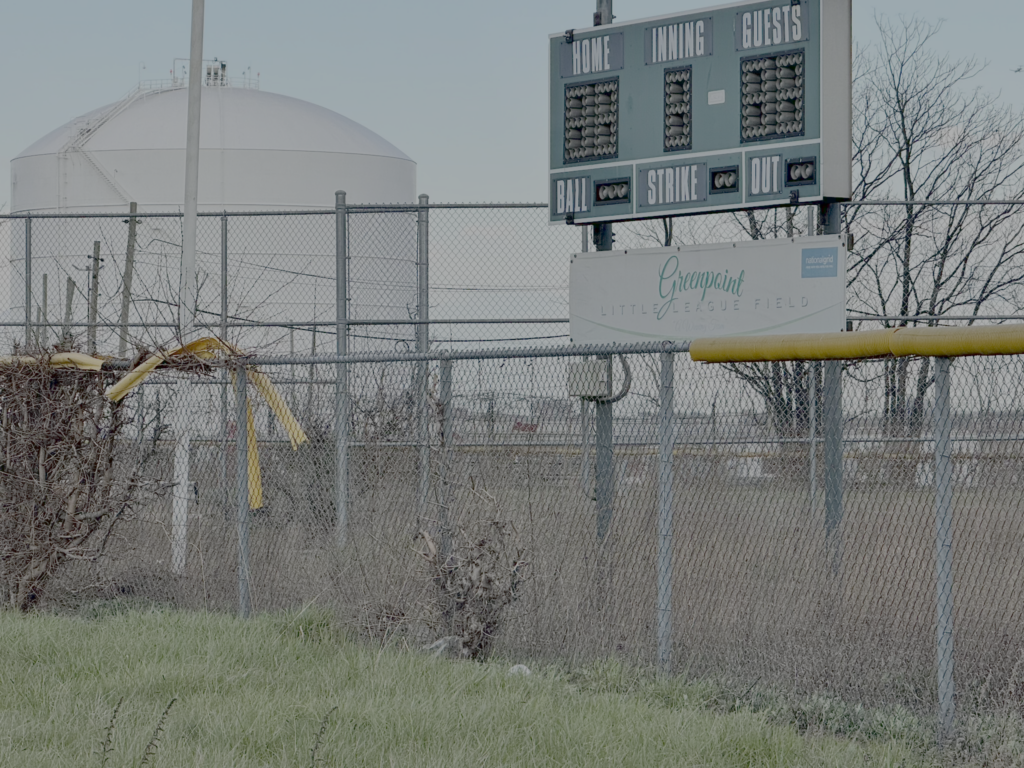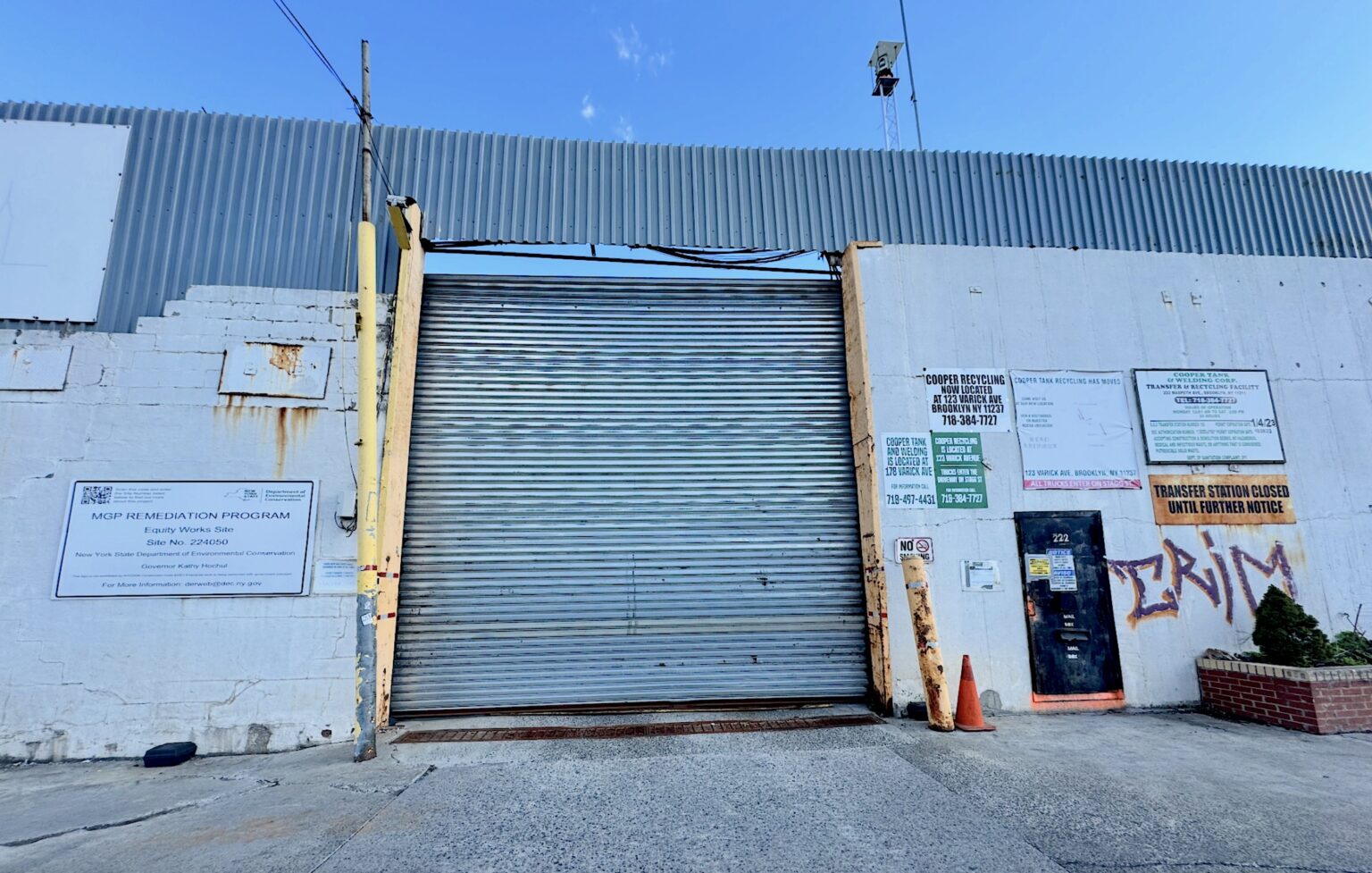New York City’s second largest utility is being sued in federal court for the alleged inappropriate handling of at least 77 tons of radioactive waste at a 120-acre site located in Brooklyn, the city’s most populous borough.
The radioactive waste, as well as other hazardous coal waste, is a leftover of a bygone era, more than a century ago, when the parcel was the location of Equity Works, a manufactured gas plant (MGP) that derived gas from heating coal, and then piped it across the city to power lighting, cooking, and heating.
Cooper Tank & Welding, which purchased the site from London-based National Grid in 1987, is seeking “no less than $2,000,000” in damages, charging in its lawsuit that the multinational electric and gas utility’s “negligent operating and waste management practices resulted in contamination” from “concentrated radioactive materials,” as well as “coal tar and other hazardous substances.”
The facility is located at the edge of the Greenpoint and Williamsburg neighborhoods, though the New York State Department of Health (DOH) responded with assurances that no communities are at risk from the radioactive waste at the former Equity Works site.
These neighborhoods have already received significant contamination connected to the oil and gas industry. At nearby Newtown Creek, a waterway that serves as a border between the boroughs of Brooklyn and Queens, refineries spilled tens of millions of gallons of oil and other petroleum products from the early to mid-20th century. The EPA listed the spill as a Superfund site in 2010.

The newly revealed radioactive coal waste, which dates back to the late nineteenth century, stands as concerning evidence that fossil fuels have a contaminating life-span that reaches forward decades and even centuries.
Cooper’s suit alleges that the utility has refused “to take responsibility for” the “technologically enhanced naturally occurring radioactive materials,” or TENORM, sitting on the expansive site, which occupies several city blocks. TENORM refers to naturally occurring radioactive wastes brought to the surface by mining for coal, oil, gas, and other minerals, which can often include substantial amounts of uranium, thorium, radium, and radon. Industrial processes can accumulate and concentrate this radioactivity at facilities and infrastructure that transport, treat, and process these minerals and fuels. Unless sites are cleaned up, the radioactive contamination may linger for centuries, perhaps millennia.
Cooper also alleges that National Grid intentionally withheld information regarding the presence and management of TENORM at the site, and that the utility’s negligence in “transporting, handling, storing, and/or disposing” of the waste “resulted in the release of radioactive materials.”
Sive, Paget & Riesel, the attorneys representing Cooper Tank & Welding, have not responded to questions about the lawsuit.
The New York State Department of Environmental Conservation (DEC) says there are 242 manufactured gas plantsites across the state, dating from the late 1800s to the mid-1900s, and that the agency has been working to clean them up since 1984.
While there are approximately 75 former MGPs located within New York City, this Brooklyn site is the only known location in the city contaminated by TENORM, according to DEC spokesperson John Salka. The state has a “proven track record of successfully investigating and cleaning up contaminated sites across New York City and the state,” said Salka.
DEC ensures that “the cleanups are fully protective of public health and the environment,” Salka said, “and works closely with partners, including the U.S. Environmental Protection Agency (EPA) and the New York State Department of Health (DOH), to ensure requirements are in place to protect communities.”
“The contractors working at the site are experienced in dealing with sites contaminated with radioactive materials,” said Erin Clary, a deputy communications director at DOH, and “there are procedures in place to prevent migration of radioactive materials offsite.”
“Workers passing through or even spending several hours at the site would not receive a radiation dose that would result in any health consequences,” Clary added.
Subscribe to our newsletter
Stay up to date with DeSmog news and alerts
An EPA assessment of the site performed in mid-November 2024, at the request of the DEC, “found elevated radiological survey readings in the areas [where] National Grid discovered elevated radiological readings in previous surveys,” said Nikita Joshi, a spokesperson for EPA Region 2, which includes New York.
Heating coal to create gas has left behind a toxic legacy at MGP sites, according to a DEC website. Surface and subsurface soil, groundwater, and organisms have been contaminated by toxic coal tar. Some locations, like the former Equity Works site in Brooklyn, are also contaminated with “purifier waste,” which has a very strong odor and a tendency to spontaneously ignite.
“It was a filthy process,” said Michael Gerrard, director of the Sabin Center for Climate Change Law at Columbia University. “Hundreds of contaminated sites were left behind for future generations to clean up.”
***
From 1892 through 1921, Brooklyn Union Gas operated the Equity Works plant at this site, which sits on what is today Maspeth Avenue, at the edge of the Greenpoint and Williamsburg neighborhoods. It is within walking distance of two popular local green spaces, McCarren Park and McGolrick Park, and several blocks from the Cooper Park public housing complex.
“At 120 acres, National Grid’s Brooklyn site has the largest footprint of any fossil fuel facility in the city of New York,” said Kim Fraczek, director of the Sane Energy Project, a New York City-based environmental advocacy group that has been working for years to curtail fracked gas infrastructure in the city.
The Sane Energy Project was part of a coalition of environmental and community groups that successfully shut down a National Grid project to transport fracked gas from Pennsylvania through — and beneath — Brooklyn, to a liquified natural gas storage facility in Greenpoint.
The Maspeth Ave. site was included in that project, which the coalition argued would encourage and enable additional fracking, prolong the city’s dependence on fossil fuels, and pose the threat of a gas leak or explosion to the largely Black and Latino/Hispanic neighborhoods along the pipeline’s pathway.
“They should be shutting [this site] down and remediating the land, and we have overwhelming community support for that,” said Fraczek. “But National Grid doesn’t want it shut down because they don’t want to be left with the bag of cleaning it up,” she said, “and now we know cleaning it up includes cleaning up long-standing radioactive fossil fuel waste.”
“National Grid will not be providing a statement on pending litigation related to this matter,” said spokesperson Alexander Starr.

TENORM can be a challenge to clean up, because the concentrated radioactive substances adhere to piping, pumps, and valves, and contaminates soil and water. Sites may include tanks and impoundments containing radioactive sludge. “It is common that these wastes come in very large volumes but low radioactivity, so it costs a lot to manage and dispose while posing a chronic, low-dose hazard,” says Phil Egidi, a former staff scientist in the EPA’s Radiation Protection division.
“EPA’s Office of Air and Radiation has been focused on keeping the planet from turning into an air fryer,” said Egidi, “and frankly did not have the bandwidth, funding, or political clout to do anything with TENORM [in] the eleven years I was there — the sludge has to wait.”
Since the mid-2010s, a number of companies have been involved in either disposing of or removing both toxic and radioactive wastes from the Brooklyn site.
According to a November 2017 Equity Works MGP remediation report prepared by AECOM, a geotechnical services company, an environmental services company called Tradebe removed more than 11,000 gallons of flammable coal tar-contaminated wastewater between 2015 and 2017. At least a portion of that waste was disposed of at a Tradebe facility located in Bridgeport, Connecticut.
From March 2017 through July 2019, a New Jersey-based waste hauling company called Environmental Transport Group, Inc., transported more than 9,000 gallons of coal tar-contaminated wastewater to an industrial facility in Middlesex, New Jersey, operated by the French environmental services firm Veolia.
Other companies have handled the radioactive materials. “Seventy-seven tons of soil were excavated by National Grid’s contractor as part of the Former Equity MGP interim cleanup work,” said Salka. This soil, which included TENORM, was transported by truck in mid-April 2024 to the Fairless Landfill in Morrisville, Pennsylvania, 30 miles north of Philadelphia.
The landfill is operated by Waste Management, the nation’s largest solid waste disposal company.
The website for the Fairless Landfill says it is “conveniently located in Falls Township, Bucks County, Pennsylvania” and that it “does not accept hazardous waste or liquid waste.”
Waste Management has not replied to questions regarding the TENORM waste from the National Grid site.
DeSmog has filed a Freedom of Information Law request with the New York State Department of Environmental Conservation to obtain additional information regarding the nature of the waste.
“This facility is at the epicenter of our fight,” said Fraczek. “Our desired outcome is for them to retire it and create a stakeholder group of local residents, professionals and regulators to come up with a decommission plan that makes sense.”
Subscribe to our newsletter
Stay up to date with DeSmog news and alerts







